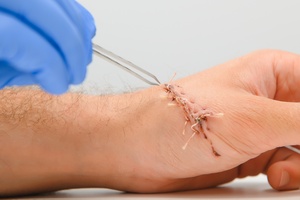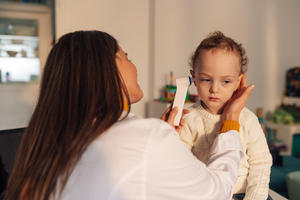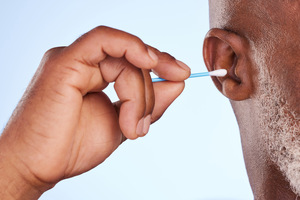Key points
- Skin infections can be caused by bacteria, viruses, fungi, or parasites, each resulting in different symptoms and requiring specific treatments.
- Infections occur when these pathogens invade the skin and its underlying tissues, often through a break in the skin.
- The severity of skin infections can be influenced by the individual's immune system and the depth of the infection.
- Prevention of skin infections involves good hygiene practices, regular healthcare visits, and staying up-to-date with vaccinations.
- Preventive measures against skin infections include regular and thorough skin washing, avoiding sharing personal items, regular healthcare visits, and staying updated with vaccinations.

How Does a Skin Infection Happen?
Skin infections occur when germs such as bacteria, viruses, or fungi invade the skin and its underlying tissues, according to Healthline. They explain that the skin is the body's largest organ and serves as a protective barrier against external threats. It consists of multiple layers, including the epidermis, dermis, and subcutaneous tissue. When a break in the skin, such as a cut or abrasion, occurs, it provides an entry point for germs to penetrate the layers of the skin, leading to infection. The deeper the infection goes, the more severe it can become, potentially causing complications if left untreated, according to Healthline.
Even minor cuts, scrapes, or insect bites can allow germs to enter the skin and cause infection, according to Healthline. Additionally, conditions such as eczema or psoriasis, which compromise the skin's integrity, can also make individuals more susceptible to skin infections, they note. Understanding how these infections occur and the factors that contribute to their development is crucial in preventing and managing skin infections effectively.
Common Types of Skin Infections
Skin infections can range from bacterial and viral to fungal and parasitic, each requiring specific approaches for effective treatment and management. Common types of skin infections, according to Healthline, include:
Bacterial Skin Infections
Bacterial skin infections encompass a range of conditions such as cellulitis, impetigo, boils, and Hansen’s disease (leprosy). These infections are caused by various types of bacteria and can result in symptoms such as redness, swelling, warmth, and tenderness at the site of infection. MRSA is a medication-resistant bacterial infection caused by staphylococcus aureus, that usually requires intensive treatment, such as oral antibiotics, according to Healthline. MRSA infections can be contagious in some cases, so it is important to take precautions if you are exposed to anyone who has a staphylococcus aureus infection, according to the Cleveland Clinic.
Viral Skin Infections
Viral skin infections include shingles (herpes zoster), chickenpox, Molluscum contagiosum, warts, measles, and hand, foot, and mouth disease. These infections are caused by different viruses and can manifest as rashes, blisters, and other skin lesions, often accompanied by systemic symptoms.
Fungal Skin Infections
Fungal skin infections encompass conditions such as athlete’s foot, yeast infections, ringworm, nail fungus, oral thrush, and diaper rash. These infections are caused by various types of fungi and can lead to symptoms such as itching, redness, scaling, and discomfort in the affected areas.
Parasitic Skin Infections
Parasitic skin infections include infestations such as lice, bedbugs, and scabies. These infections are caused by different parasites and can result in intense itching, skin irritation, and visible signs of infestation. Understanding the characteristics of each type of skin infection is essential in determining the appropriate treatment and management strategies.
Symptoms of Skin Infections
Symptoms of skin infections can be as varied as the pathogens that cause them, often influenced by the type of infection and the individual’s immune system, according to Healthline. They note that while some people may experience mild symptoms, others with compromised immunity might face more severe manifestations.
The body's ability to fight off infection plays a significant role in the severity and progression of symptoms, according to WebMD. It is important to pay attention to the body's signals, as early detection of these symptoms can lead to more effective treatment and a quicker resolution of the infection.
Below is a list of common symptoms that can be associated with skin infections, according to WebMD:
-
Itchy skin
-
Redness or erythema
-
Different types of lesions, including bumps, lumps, or rashes
-
Pain and tenderness in the affected area
-
Skin sloughing or shedding
-
Formation of blisters or vesicles
- Skin abscesses
-
Pus or discharge from lesions (cuts or abrasions that open the skin)
-
Discoloration of the skin, which may appear darker or lighter than the surrounding area
-
Swelling or inflammation
-
Increased warmth in the affected area
Each of these symptoms can indicate a skin infection, but their presence alone does not confirm a diagnosis, notes WebMD. Medical evaluation is essential to determine the cause and appropriate treatment of skin symptoms.
Causes and Risk Factors of Skin Infections
The causes of skin infections are as diverse as the pathogens that initiate them, with each type of infection stemming from a different source, according to Healthline. They explain that bacteria, viruses, fungi, and parasites are all potential culprits, each exploiting different routes to invade and infect the skin.
Understanding the specific causes and risk factors associated with each type of skin infection is vital for prevention and effective treatment, according to Healthline. Environmental factors, personal hygiene, and the health of one's immune system can all influence susceptibility to skin infections.
Some of the common causes and risk factors for each category of skin infection, according to Healthline, include:
Bacterial skin infections:
-
Breaks in the skin such as cuts, abrasions, or puncture wounds allow bacteria to enter and multiply.
-
Contact with contaminated surfaces or infected individuals.
-
A weakened immune system can make it harder for the body to fight off bacterial invaders.
-
Underlying skin conditions like eczema or acne that can compromise the skin's protective barrier.
Viral skin infections:
-
Direct contact with an infected person or contaminated objects, as many viral infections are highly contagious.
-
Exposure to the virus in public places, such as swimming pools or gyms.
-
Immune system deficiencies that make it more difficult to fend off viral agents.
-
Not being vaccinated against common viral infections like chickenpox or HPV.
Fungal skin infections:
-
Warm, moist environments that foster fungal growth, such as sweaty shoes or public showers.
-
Direct contact with an infected person or animal.
-
Sharing personal items like towels or clothing that may be contaminated with fungi.
-
A compromised immune system can increase vulnerability to fungal infections.
Parasitic skin infections:
-
Close physical contact with an infected person or contact with items such as bedding or clothing harboring parasites.
-
Travel to areas with poor sanitation or where parasitic infections are more common.
-
Insect bites that can transmit parasites, such as mites or lice.
-
Poor personal hygiene, which can increase the risk of contracting and spreading parasitic infections.
How to Treat Skin Infections
When it comes to treating skin infections, the approach varies depending on the type of infection and its severity, according to Healthline. Seeking professional medical advice is crucial, as healthcare providers can accurately diagnose the infection and recommend appropriate treatment, they note.
Treatment options may include prescription medications such as antibiotics for bacterial infections, antivirals for viral infections, antifungals for fungal infections, and antiparasitic medications for parasitic infections. In addition to medical intervention, several supportive measures can aid in managing the symptoms of skin infections. Some options, according to Healthline may include:
-
Over-the-counter antihistamines to alleviate itching and discomfort.
-
Application of cold compresses to reduce inflammation and soothe itching.
-
Use of topical creams or ointments to alleviate redness and itching, and promote healing of the affected skin.
It's important to follow the healthcare provider's recommendations and complete the full course of any prescribed medications to ensure the infection is effectively treated, according to Healthline.
How to Prevent Skin Infections
Preventing skin infections involves adopting various proactive measures to minimize the risk of exposure to pathogens, according to Healthline. They note that good hygiene practices and lifestyle choices can significantly contribute to reducing the likelihood of developing skin infections. Here are some strategies for preventing skin infections, according to Healthline:
-
Practice regular and thorough washing of the skin, ensuring proper drying to prevent the buildup of moisture, which can create an environment conducive to infection.
-
Avoid sharing personal items such as towels, razors, and clothing to minimize the risk of cross-contamination.
-
Schedule routine visits to a healthcare provider to monitor and maintain skin health, addressing any concerns or changes promptly.
-
Stay up to date with recommended vaccinations to protect against common infectious diseases that can manifest as skin infections.
By incorporating these preventive measures into daily routines and seeking professional guidance, individuals can take proactive steps to safeguard their skin health and reduce the risk of skin infections.
Lab tests near me
SolvHealth provides a convenient platform to search for nearby healthcare facilities offering lab testing services. By simply entering your location and specifying the type of lab test you require for the skin infection, we can help you locate suitable providers in your area.
FAQs
What causes skin infections?
Skin infections are caused by bacteria, viruses, fungi, or parasites. These pathogens invade the skin and its underlying tissues, often entering through a break in the skin.
What are the symptoms of skin infections?
Symptoms can vary but may include itchy skin, redness, different types of skin lesions, pain and tenderness in the affected area, skin sloughing, formation of blisters, skin abscesses, pus or discharge from lesions, discoloration of the skin, swelling or inflammation, and increased warmth in the affected area.
How are skin infections treated?
Treatment depends on the type of infection and its severity. It may include prescription medications such as antibiotics, antivirals, antifungals, or antiparasitic medications. Supportive measures like over-the-counter antihistamines, cold compresses, and topical creams can also help manage symptoms.
How can I prevent skin infections?
Prevention involves good hygiene practices, avoiding sharing personal items, regular healthcare visits, and staying up-to-date with recommended vaccinations.
Are all skin infections contagious?
Not all skin infections are contagious, but many, especially those caused by bacteria, viruses, and parasites, can be spread through direct contact or sharing of personal items.
Can skin infections be severe?
Yes, skin infections can be severe, especially in individuals with compromised immunity.
Are all skin infections caused by direct contact with an infected person?
No, not all skin infections are caused by direct contact with an infected person. They can also be caused by contact with contaminated surfaces or due to a weakened immune system or underlying skin conditions.
Are over-the-counter treatments effective for all skin infections?
No, over-the-counter treatments may not be effective for all skin infections. The treatment depends on the type and severity of the infection, and may require prescription medications.











